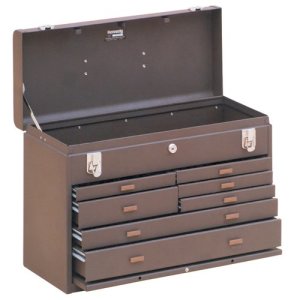Are you new to the Machining industry or considering a career in this field of manufacturing? A toolbox is one of the first things that you should buy. It’s where you will keep most if not all of your tools, personal inspection equipment, and books/manuals such as the Machinery’s handbook.
Kennedy tool boxes are well known in the Machining industry because they are well built and have been around for 100 years now. If you’re looking for a tool box that is made in the U.S.A., a Kennedy is the way to go for a new Machinist, whether it’s a top box, or a bottom as well. These boxes are made specifically for Machinists, so the length, width, and depth of each drawer is designed for specific tools, allowing you to easily organize your set-up; and we all know that time is money when running CNC machines.

If you’re on a budget, a standard tool box can work just about as well. It may not be built to hold your machining tools as well, but you can find good deals on sturdy boxes that will save you money for buying even more tools!
There are also some Machinist knock-off tool boxes are on Amazon for a fraction of the cost, such as this 11 Drawer Roller Box. Due to its low price, it won’t have the same quality as say a Kennedy, but some of the same features are there with a similar layout. Like most anything these days, you generally get what you pay for. For something such as a tool box, if you’re a rookie machinist, then a cheap box may work just fine.
What To Look For?
If you are just starting your CNC Machinist classes at the local Tech school and had to buy a tool box without doing any research then it probably won’t make much difference at first. After going to school or working for some time, though you’ll realize what you want in a tool box, and even that may change after being on the job for years.
Size is the biggest factor when purchasing a new tool box. Obviously if space is unlimited and you don’t plan on transporting it often or ever, then the bigger the better. If you buy a big box right away then you won’t have to upgrade right after buying a handful of new tools. On the flip side, if you don’t have many tools then you’ll be pushing around a lot of dead weight if you move around the shop on a weekly or daily basis.
If you have a chance to look at and test out tool boxes in person, I would suggest looking at and opening the drawers to see how smooth they are. Ball-bearing drawers slide out nicely compared to the conventional slides. This feature isn’t necessarily a deal breaker, but it’s always nice to have things that perform better.
Castors are the wheels used on tool boxes and are another feature that should be considered when doing research. Putting a lot of heavy tools in your box will put more strain on the castors, so it’s good to have big and sturdy castors.
If you still can’t figure out which one to buy, there’s nothing wrong with having one, two, or three boxes to choose from.
A quick tip on how to prevent tools from getting nicked and scratched up after constant opening and closing of drawers; tape a sheet of felt or lay a thin rubber mat down in each drawer for padding and to help prevent everything from sliding around.
